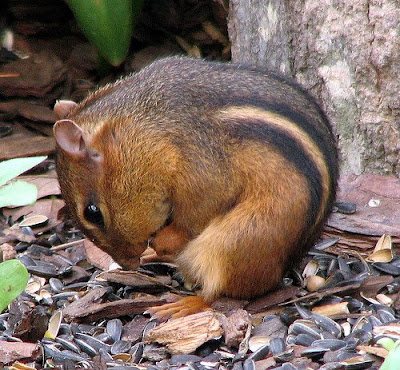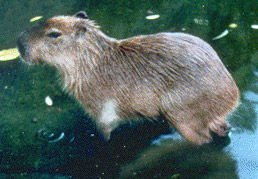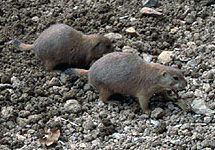
Adorable photo of a Jerboa.
A blog dedicated to everything rodents.

 I got these adroable pictures of a Dormouse on Cute Overload (CuteOverload.com).
I got these adroable pictures of a Dormouse on Cute Overload (CuteOverload.com).Dormice are omnivorous, typically feeding on fruits, berries, flowers, nuts and insects. Dormice are unique among rodents in that they lack a cecum, a part of the gut used in other species to ferment vegetable matter. Their dental formulasquirrels, although they often lack premolars: is similar to that of
Dormice breed once or twice a year, producing litters with an average of four young after a gestation period of 21-32 days. They can live for as long as five years. The young are born hairless, and helpless, and their eyes do not open until about eighteen days after birth. They typically become sexually mature after the end of their first hibernation. Dormice live in small family groups, with home ranges that vary widely between species, and depending on the availability of food[1].One of the most notable characteristics of those dormice that live in temperatehibernation. Dormice can hibernate six months out of the year, or even longer if the weather remains sufficiently cool, sometimes waking for brief periods to eat food they had previously stored nearby. During the summer, they accumulate fat in their bodies, to nourish them through the hibernation period[1]. zones is
It is from this trait that they got their name, which comes from Anglo-Normandormeus, which means "sleepy (one)"; the word was later altered by folk etymology to resemble the word "mouse". The sleepy behaviour of the Dormouse character in Lewis Carroll's Alice's Adventures in Wonderland also attests to this trait.
| Kingdom: | Animalia |
| Phylum: | Chordata |
| Class: | Mammalia |
| Order: | Rodentia |
| Suborder: | Sciuromorpha |
| Family: | Gliridae |








 Lodgepole Chipmunk. Photo by Dr. Lloyd Glenn Ingles © 1999 California Academy of Sciences. |
The single largest group of mammals is the Rodentia. Most non-flying mammals are rodents: there are about 1,500 living rodent species (out of about 4,000 living mammals overall). Most people are familiar with mice, rats, hamsters, and guinea pigs, which are commonly kept as pets. The Rodentia also includes beavers, muskrats, porcupines, woodchucks, chipmunks, squirrels, prairie dogs, marmots, chinchillas, voles, lemmings, and many others. (Incidentally, the Rodentia does not include rabbits; rabbits differ from rodents in having an extra pair of incisors and in other skeletal features. Rabbits, hares, and a few other species make up the Lagomorpha. Shrews, moles and hedgehogs are also not rodents; they are classified in the Insectivora.)
Rodents are found native on all continents except Antarctica. One particular family of rodents, the Muridae, contains over 1100 species: over a quarter of all mammal species are rats, mice, voles, muskrats, lemmings, hamsters, gerbils, and other members of the Muridae. However, rodents show perhaps their greatest diversity of form in South America, which was an isolated continent for much of the Cenozoic. A few of these distinctive South American rodents include mountain viscachas, rabbit-like forms that inhabit dry mountainous regions; Patagonian cavies, very rabbit-like, fast-running forms with elongated ears and short tails; the coypu or nutria, a large marsh-dwelling rodent that has been introduced into North America and is hunted for its fur; and various burrowing forms such as pacas and tuco-tucos. Other South American rodents include guinea pigs, chinchillas, and New World porcupines (one species of which has dispersed into North America). The capybara (shown
 |
Despite their great species diversity, all rodents share common features. Rodents have a single pair of incisors in each jaw, and the incisors grow continually throughout life. The incisors have thick enamel layers on the front but not on the back; this causes them to retain their chisel shape as they are worn down. Behind the incisors is a large gap in the tooth rows, or diastema; there are no canines, and typically only a few molars at the rear of the jaws. Rodents gnaw with their incisors by pushing the lower jaw forward, and chew with the molars by pulling the lower jaw backwards. In conjunction with these chewing patterns, rodents have large and complex jaw musculature, with modifications to the skull and jaws to accommodate it. Like some other mammal taxa, but unlike rabbits and other lagomorphs, male rodents have a baculum (penis bone). Most rodents are herbivorous, but some are omnivorous, and others prey on insects. Rodents show a wide range of lifestyles, ranging from burrowing forms such as gophers and mole rats to tree-dwelling squirrels and
 |
Rodents cost billions of dollars in lost crops each year, and some are carriers of human diseases such as bubonic plague, typhus, and Hanta fever. However, various rodent species are economically important as sources of food or fur in many parts of the world, and others are used extensively in biomedical research.
Many early mammal taxa were superficially rodent-like, such as the extinct multituberculates. However, true rodents first appear in the fossil record towards the end of the Paleocene epoch. Their ancestry is probably to be found among a group of small fossil mammals known as anagalids, which may also have given rise to the Lagomorpha. The living rodent with the most archaic characters, most like the common ancestor of the Rodentia, is the sewellel or mountain beaver (which is not a true beaver at all) of the northwestern United States. During the Oligocene, the South American rodents began their great evolutionary radiation. By the Miocene, very modern-looking squirrels had evolved, as had the murids. Murids began their spectacular radiation in the Pliocene.
Noteworthy Pleistocene rodents include the extinct giant beaver, Castoroides, which was about the size of a bear. More prosaic rodent fossils from this time period, notably the teeth of voles and mice, have become important in reconstructing global climate patterns as well as in fine-scale studies of evolution.

HELEN PEARSON
Some mice are cleverer than others, say US neuroscientists. Their rodent equivalent of an IQ test might fuel the controversial pursuit for genes linked to human intelligence.
Scientists have long used a factor called general intelligence or 'g' to rate people's brainpower. The measure spans verbal, logical and mathematical tasks - so a person with a big 'g' tends to score highly in all intelligence quotient (IQ) tests, and do well in school and work.
Mice have a version of 'g', according to a team led by Louis Matzel of Rutgers University in Piscataway, New Jersey1. Animals that come top in one learning test often score better on others, they found: a maze champion might be a sniffing sensation too. "Once in a while you come across one that's absolutely stunning," says Matzel.
This might sound obvious - but because the tests are so laborious, few people have examined whether there are general differences between individual animals. Many studies average and compare the scores of groups of mice using one or two learning tasks.
Matzel's results imply that some mice have a general learning ability rather than, say, just being good at navigating or discriminating. This factor seems to underpin around 40% of the difference in task performance between individual mice, Matzel's team found.
Human 'g' also accounts for about 40% of variation in intelligence tests. "It's a terrifically important paper," says Robert Plomin, who studies intelligence at King's College, London. "It's by far the most stringent test of the hypothesis that you can find 'g' in mice."
Sceptics point out that Matzel's general learning factor may actually be a measure of a mouse's curiosity, motivation or athletic ability. "You might be testing what it's easy to test," warns psychologist Howard Gardner of Harvard University in Cambridge, Massachusetts.
Matzel is already comparing the brain genes that are active in mice with high and low 'g' values. These might help re-wire nerve cells or boost signal firing.
Many experts are wary of this line of research, however. It raises the prospect that people might be labelled as clever or stupid on the basis of their genetic code, or that parents could screen embryos for intelligence genes.
Geneticists counter that such studies might instead reveal ways in which we can boost intelligence using, for example, nutrition or education. "They are difficult issues - but they're not as worrisome as we think," Plomin says.
Others argue that 'g' is a poor measure of human intelligence anyway. IQ tests, they say, are too crude to pick up individual talents. Gardner, for example, proposes that there are several distinct types of intelligence, such as logical, musical and interpersonal.

